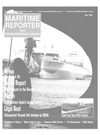
New Measures on Ballast Water Management Approval
"Back to the drawing board" is the message to designers of new vessels, as ballast water management is to become a major consideration in the design of new vessels following the approval by IMO of a series of measures aimed at reducing the effects of marine organisms transported in ballast water and the risks involved in some ballast water management techniques.
The 47th session of the International Maritime Organization's Marine Environment Protection Committee (MEPC). which met in March in London, approved a Circular containing design suggestions for ballast water and sediment management options in new ships.
The Circular says that ballast water management and the processes chosen to achieve it should be considered as a basic component of a ship's design and that ballast tank design should facilitate all aspects of ballast water management. Among the new equipment sought, the Circular notes that installation of recording equipment should be considered for all ballast water operations and treatment actions and it should be possible for these records to be readily available to appropriate authorities that may request copies.
It goes on to say that ballast water system designs should take special account of the increased need for content sampling, with an aim to enhancing the quality and ease of sampling of ballast water and sediments, without the need to enter potentially dangerous spaces or to partially fill ballast tanks.
Where ballast water exchange at sea is the chosen method, the overall design, strength and stability of the ship should be sufficient to permit its execution on all ballast voyages and in all except severe weather conditions.
For the guidance of the master, the maximum sea state and swell conditions identified by the builder, if any. in which ballast water exchange can safely be carried out should be recorded in a Ballast Water Management Plan, which should be created for every ship.
This plan should give guidance on safe and effective operation of the various ballast water management and treatment options that are considered appropriate for the ship. The design of the ship should include consideration of the consequences of ballast water exchange at sea including: stability, hull girder strength, shear forces, resonance, sloshing, stemming, propeller immersion, limitations brought about by insufficient strength in various parts of the ship when the tanks are sequentially emptied and appropriate strengthening incorporated to allow this operation to be conducted safely. A draft international convention for the control and management of ships' ballast water and sediments as well as associated guidelines for its implementation is being developed for consideration and adoption by a diplomatic conference scheduled for 2003.
Other stories from May 2002 issue
Content
- Delta Queen Makes A Comeback page: 3
- USS Cole Returns to Fleet page: 4
- Polar Discovery Christened at Avondale page: 7
- Heidenreich Marine Reorganizes Companies page: 8
- Transas Breaks Through Visual Technology page: 8
- Navibulgar Finalizes Varna Shipyard Deal page: 9
- Horbeck-Leevac To Build Eight OSV's page: 9
- Navibulgar Initiates Fleet Renewal Program page: 9
- OSHA Standards Applicable on Uninspected Vessels page: 10
- Munson Delivers PACKCAT to U.S. Navy page: 11
- U.S. Navy Awards Northrop Grumman $ 1 . 3 B LHD Contract page: 11
- Shipboard Life in Style page: 12
- Has the Fast Cat Come to A Halt? page: 15
- Market Changes Mold RoRo Ship Conversions page: 16
- Seville Delivers RoPax Ferry page: 18
- Crankshaft Care Key to Vessel Profitability page: 19
- AIS:When & Where? Here & Now! page: 20
- Crowley Subsidiary Christens ATB page: 24
- Ballast Water Treatment Through Biodispersion page: 26
- LNG Breakthrough For Wartsila page: 29
- New Measures on Ballast Water Management Approval page: 32
- The GMD Group - A Young, Ambitious Team page: 33
- Seven Seas Mariner Undergoes Pod Adjustment page: 34
- Teekay Foam's Discharge Pipe Repaired in Bilbao page: 36
- Government Ships Spend Time At Cascade page: 38
- ASRY Continues Brisk Repair Pace page: 39
- FRP Pumps Offer Lasting Results page: 40
- Spray-On Insulation Cuts Maintenance Costs page: 42
- SEI Temp-Set Reusable Insulation Covers page: 42
- EU to Develop Sulfur Strategy page: 43
- CITGO Offers "No Sheen" Aquamarine Oils page: 43
- Good Fuel = Good Profits page: 44
- Lubes Keep Step With Diesel Development page: 44
- Jeamar's Winches Are Made To Order page: 45
- Victoria Shipyard Racks Up Cruise Ship Jobs page: 45
- Targeting Greek Shipping's $16B Budget page: 46
- Elefsis Helps Speed LNG Retrofit page: 47
- Stelmar Set To Expand Fleet, Receives Tanker page: 51
- HHI: To Infinity & Beyond page: 52
- Dual-Fuel Finds A New Backer page: 57
- U.S. Navy Selects Gold Team For DD(X) page: 57
- Packing Solutions Help Bear Set Sail page: 57

